Adobe Performance Review Case Study
VerifiedAdded on 2019/09/18
|9
|2164
|329
Case Study
AI Summary
This case study delves into Adobe's decision to abandon traditional performance reviews, specifically the 'stack ranking' system, and their subsequent adoption of the 'check-in' approach. It explores the problems associated with stack ranking, such as decreased team collaboration, employee demotivation, and high attrition rates. The study further examines the benefits and challenges of stack ranking for both employees and organizations. It details Adobe's new check-in system, which emphasizes frequent feedback, clear expectations, and increased communication between managers and employees. The case study also discusses the positive effects of this new approach, including improved employee motivation, reduced attrition, and enhanced managerial ownership. Additionally, it considers industries where Adobe's alternative approach might not be suitable and suggests strategies for reconciling the need for strong teams with individual performance improvement. The study concludes by recommending effective performance management practices, such as providing constructive feedback, setting clear objectives, and aligning individual actions with strategic goals.
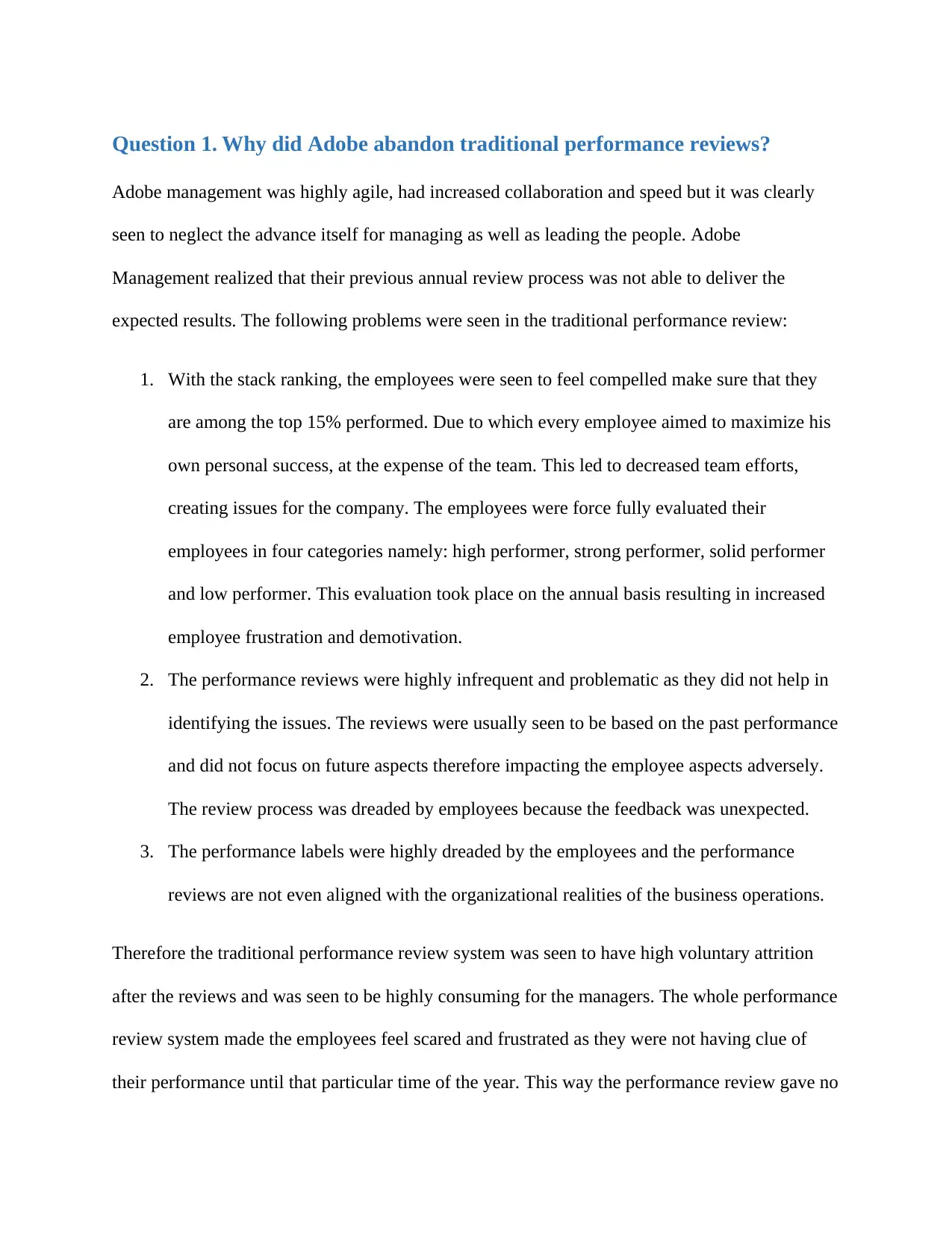
Question 1. Why did Adobe abandon traditional performance reviews?
Adobe management was highly agile, had increased collaboration and speed but it was clearly
seen to neglect the advance itself for managing as well as leading the people. Adobe
Management realized that their previous annual review process was not able to deliver the
expected results. The following problems were seen in the traditional performance review:
1. With the stack ranking, the employees were seen to feel compelled make sure that they
are among the top 15% performed. Due to which every employee aimed to maximize his
own personal success, at the expense of the team. This led to decreased team efforts,
creating issues for the company. The employees were force fully evaluated their
employees in four categories namely: high performer, strong performer, solid performer
and low performer. This evaluation took place on the annual basis resulting in increased
employee frustration and demotivation.
2. The performance reviews were highly infrequent and problematic as they did not help in
identifying the issues. The reviews were usually seen to be based on the past performance
and did not focus on future aspects therefore impacting the employee aspects adversely.
The review process was dreaded by employees because the feedback was unexpected.
3. The performance labels were highly dreaded by the employees and the performance
reviews are not even aligned with the organizational realities of the business operations.
Therefore the traditional performance review system was seen to have high voluntary attrition
after the reviews and was seen to be highly consuming for the managers. The whole performance
review system made the employees feel scared and frustrated as they were not having clue of
their performance until that particular time of the year. This way the performance review gave no
Adobe management was highly agile, had increased collaboration and speed but it was clearly
seen to neglect the advance itself for managing as well as leading the people. Adobe
Management realized that their previous annual review process was not able to deliver the
expected results. The following problems were seen in the traditional performance review:
1. With the stack ranking, the employees were seen to feel compelled make sure that they
are among the top 15% performed. Due to which every employee aimed to maximize his
own personal success, at the expense of the team. This led to decreased team efforts,
creating issues for the company. The employees were force fully evaluated their
employees in four categories namely: high performer, strong performer, solid performer
and low performer. This evaluation took place on the annual basis resulting in increased
employee frustration and demotivation.
2. The performance reviews were highly infrequent and problematic as they did not help in
identifying the issues. The reviews were usually seen to be based on the past performance
and did not focus on future aspects therefore impacting the employee aspects adversely.
The review process was dreaded by employees because the feedback was unexpected.
3. The performance labels were highly dreaded by the employees and the performance
reviews are not even aligned with the organizational realities of the business operations.
Therefore the traditional performance review system was seen to have high voluntary attrition
after the reviews and was seen to be highly consuming for the managers. The whole performance
review system made the employees feel scared and frustrated as they were not having clue of
their performance until that particular time of the year. This way the performance review gave no
Paraphrase This Document
Need a fresh take? Get an instant paraphrase of this document with our AI Paraphraser
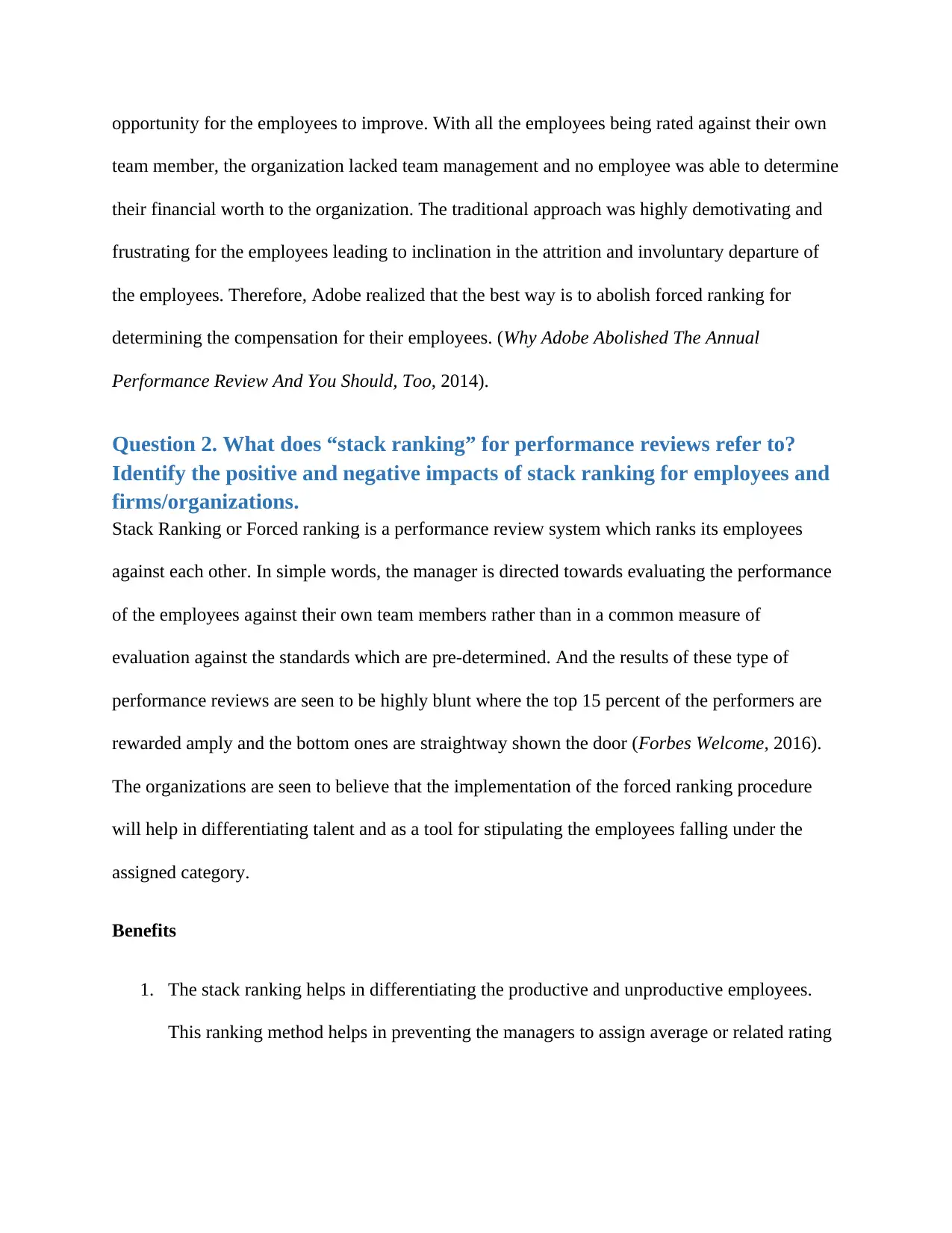
opportunity for the employees to improve. With all the employees being rated against their own
team member, the organization lacked team management and no employee was able to determine
their financial worth to the organization. The traditional approach was highly demotivating and
frustrating for the employees leading to inclination in the attrition and involuntary departure of
the employees. Therefore, Adobe realized that the best way is to abolish forced ranking for
determining the compensation for their employees. (Why Adobe Abolished The Annual
Performance Review And You Should, Too, 2014).
Question 2. What does “stack ranking” for performance reviews refer to?
Identify the positive and negative impacts of stack ranking for employees and
firms/organizations.
Stack Ranking or Forced ranking is a performance review system which ranks its employees
against each other. In simple words, the manager is directed towards evaluating the performance
of the employees against their own team members rather than in a common measure of
evaluation against the standards which are pre-determined. And the results of these type of
performance reviews are seen to be highly blunt where the top 15 percent of the performers are
rewarded amply and the bottom ones are straightway shown the door (Forbes Welcome, 2016).
The organizations are seen to believe that the implementation of the forced ranking procedure
will help in differentiating talent and as a tool for stipulating the employees falling under the
assigned category.
Benefits
1. The stack ranking helps in differentiating the productive and unproductive employees.
This ranking method helps in preventing the managers to assign average or related rating
team member, the organization lacked team management and no employee was able to determine
their financial worth to the organization. The traditional approach was highly demotivating and
frustrating for the employees leading to inclination in the attrition and involuntary departure of
the employees. Therefore, Adobe realized that the best way is to abolish forced ranking for
determining the compensation for their employees. (Why Adobe Abolished The Annual
Performance Review And You Should, Too, 2014).
Question 2. What does “stack ranking” for performance reviews refer to?
Identify the positive and negative impacts of stack ranking for employees and
firms/organizations.
Stack Ranking or Forced ranking is a performance review system which ranks its employees
against each other. In simple words, the manager is directed towards evaluating the performance
of the employees against their own team members rather than in a common measure of
evaluation against the standards which are pre-determined. And the results of these type of
performance reviews are seen to be highly blunt where the top 15 percent of the performers are
rewarded amply and the bottom ones are straightway shown the door (Forbes Welcome, 2016).
The organizations are seen to believe that the implementation of the forced ranking procedure
will help in differentiating talent and as a tool for stipulating the employees falling under the
assigned category.
Benefits
1. The stack ranking helps in differentiating the productive and unproductive employees.
This ranking method helps in preventing the managers to assign average or related rating
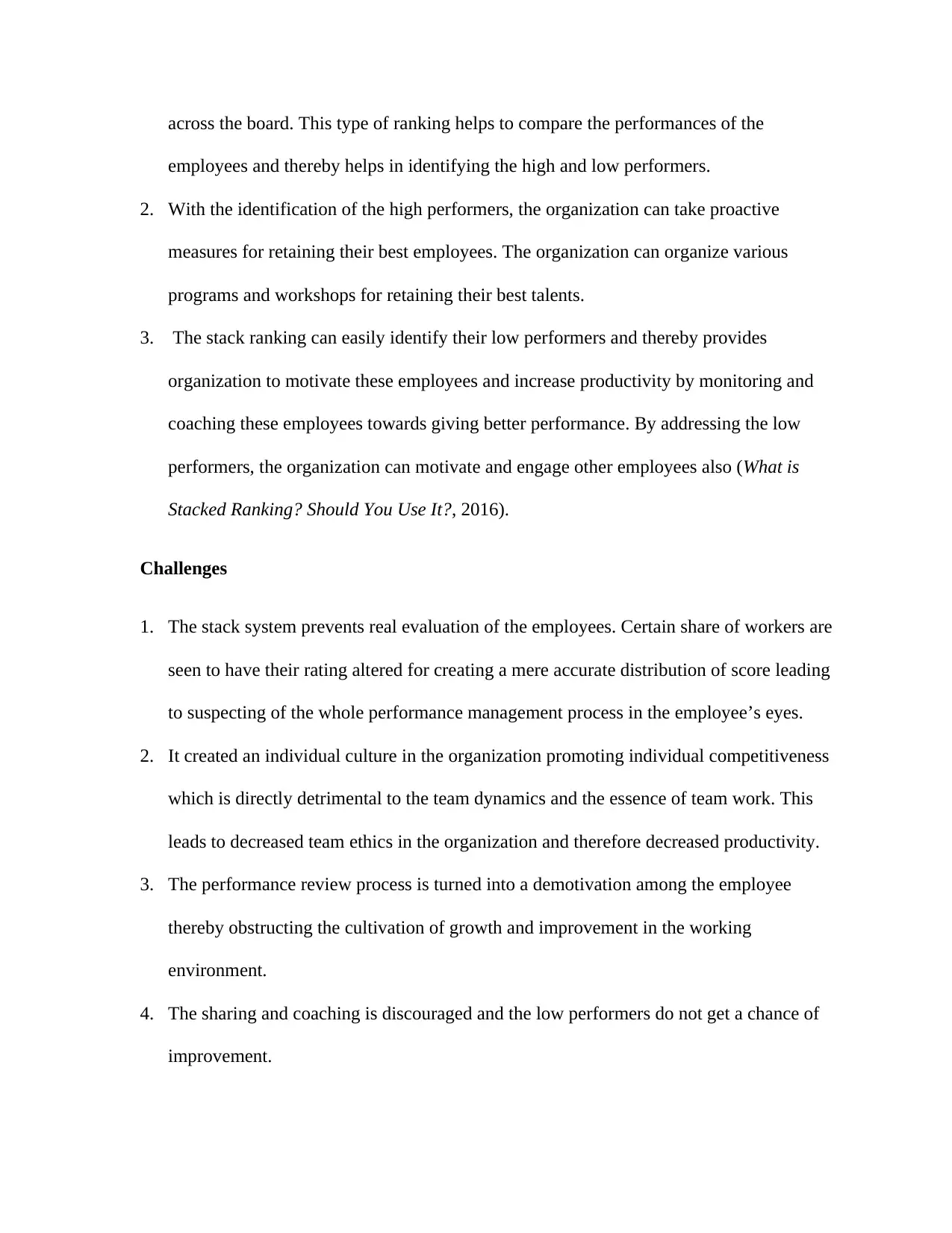
across the board. This type of ranking helps to compare the performances of the
employees and thereby helps in identifying the high and low performers.
2. With the identification of the high performers, the organization can take proactive
measures for retaining their best employees. The organization can organize various
programs and workshops for retaining their best talents.
3. The stack ranking can easily identify their low performers and thereby provides
organization to motivate these employees and increase productivity by monitoring and
coaching these employees towards giving better performance. By addressing the low
performers, the organization can motivate and engage other employees also (What is
Stacked Ranking? Should You Use It?, 2016).
Challenges
1. The stack system prevents real evaluation of the employees. Certain share of workers are
seen to have their rating altered for creating a mere accurate distribution of score leading
to suspecting of the whole performance management process in the employee’s eyes.
2. It created an individual culture in the organization promoting individual competitiveness
which is directly detrimental to the team dynamics and the essence of team work. This
leads to decreased team ethics in the organization and therefore decreased productivity.
3. The performance review process is turned into a demotivation among the employee
thereby obstructing the cultivation of growth and improvement in the working
environment.
4. The sharing and coaching is discouraged and the low performers do not get a chance of
improvement.
employees and thereby helps in identifying the high and low performers.
2. With the identification of the high performers, the organization can take proactive
measures for retaining their best employees. The organization can organize various
programs and workshops for retaining their best talents.
3. The stack ranking can easily identify their low performers and thereby provides
organization to motivate these employees and increase productivity by monitoring and
coaching these employees towards giving better performance. By addressing the low
performers, the organization can motivate and engage other employees also (What is
Stacked Ranking? Should You Use It?, 2016).
Challenges
1. The stack system prevents real evaluation of the employees. Certain share of workers are
seen to have their rating altered for creating a mere accurate distribution of score leading
to suspecting of the whole performance management process in the employee’s eyes.
2. It created an individual culture in the organization promoting individual competitiveness
which is directly detrimental to the team dynamics and the essence of team work. This
leads to decreased team ethics in the organization and therefore decreased productivity.
3. The performance review process is turned into a demotivation among the employee
thereby obstructing the cultivation of growth and improvement in the working
environment.
4. The sharing and coaching is discouraged and the low performers do not get a chance of
improvement.
⊘ This is a preview!⊘
Do you want full access?
Subscribe today to unlock all pages.

Trusted by 1+ million students worldwide
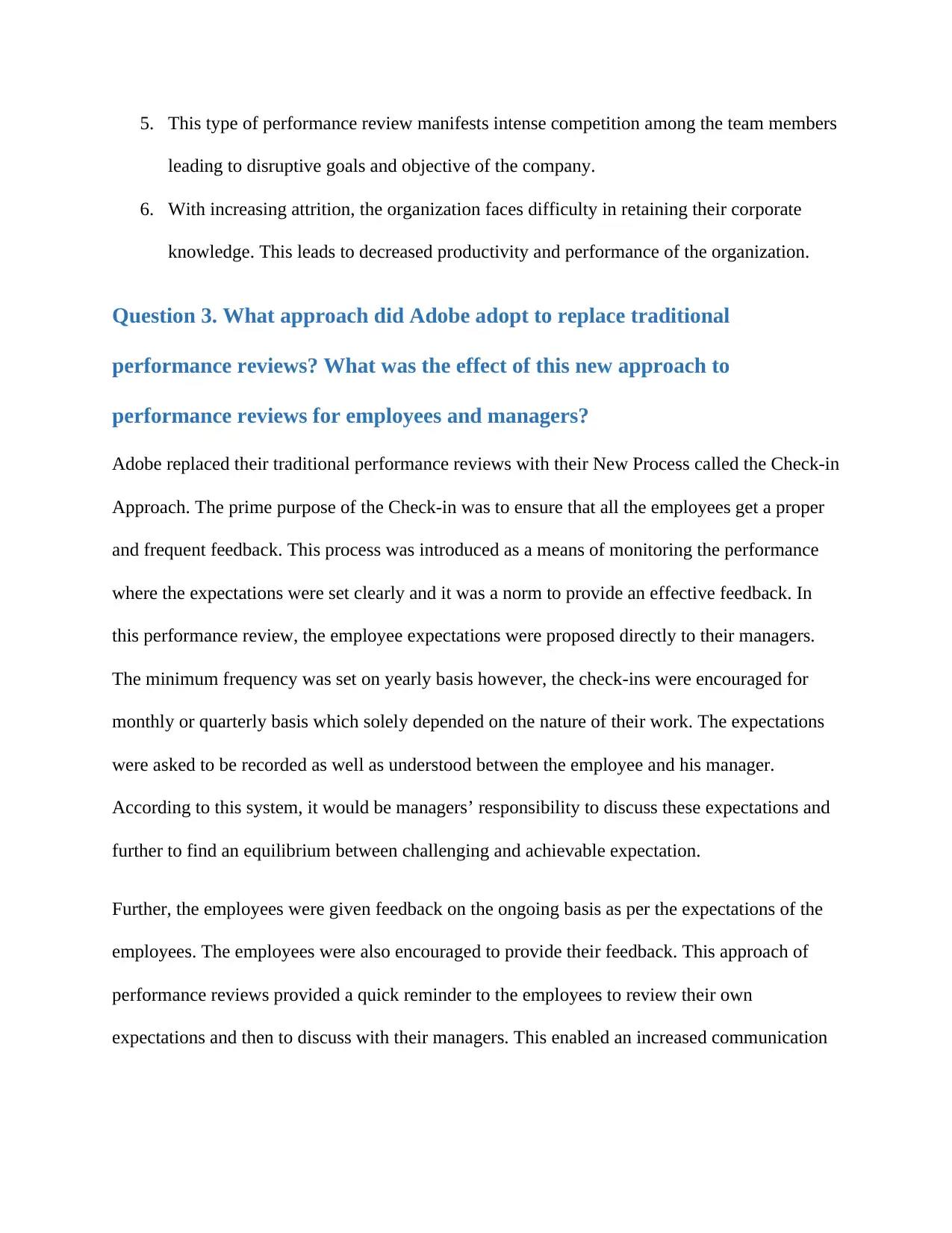
5. This type of performance review manifests intense competition among the team members
leading to disruptive goals and objective of the company.
6. With increasing attrition, the organization faces difficulty in retaining their corporate
knowledge. This leads to decreased productivity and performance of the organization.
Question 3. What approach did Adobe adopt to replace traditional
performance reviews? What was the effect of this new approach to
performance reviews for employees and managers?
Adobe replaced their traditional performance reviews with their New Process called the Check-in
Approach. The prime purpose of the Check-in was to ensure that all the employees get a proper
and frequent feedback. This process was introduced as a means of monitoring the performance
where the expectations were set clearly and it was a norm to provide an effective feedback. In
this performance review, the employee expectations were proposed directly to their managers.
The minimum frequency was set on yearly basis however, the check-ins were encouraged for
monthly or quarterly basis which solely depended on the nature of their work. The expectations
were asked to be recorded as well as understood between the employee and his manager.
According to this system, it would be managers’ responsibility to discuss these expectations and
further to find an equilibrium between challenging and achievable expectation.
Further, the employees were given feedback on the ongoing basis as per the expectations of the
employees. The employees were also encouraged to provide their feedback. This approach of
performance reviews provided a quick reminder to the employees to review their own
expectations and then to discuss with their managers. This enabled an increased communication
leading to disruptive goals and objective of the company.
6. With increasing attrition, the organization faces difficulty in retaining their corporate
knowledge. This leads to decreased productivity and performance of the organization.
Question 3. What approach did Adobe adopt to replace traditional
performance reviews? What was the effect of this new approach to
performance reviews for employees and managers?
Adobe replaced their traditional performance reviews with their New Process called the Check-in
Approach. The prime purpose of the Check-in was to ensure that all the employees get a proper
and frequent feedback. This process was introduced as a means of monitoring the performance
where the expectations were set clearly and it was a norm to provide an effective feedback. In
this performance review, the employee expectations were proposed directly to their managers.
The minimum frequency was set on yearly basis however, the check-ins were encouraged for
monthly or quarterly basis which solely depended on the nature of their work. The expectations
were asked to be recorded as well as understood between the employee and his manager.
According to this system, it would be managers’ responsibility to discuss these expectations and
further to find an equilibrium between challenging and achievable expectation.
Further, the employees were given feedback on the ongoing basis as per the expectations of the
employees. The employees were also encouraged to provide their feedback. This approach of
performance reviews provided a quick reminder to the employees to review their own
expectations and then to discuss with their managers. This enabled an increased communication
Paraphrase This Document
Need a fresh take? Get an instant paraphrase of this document with our AI Paraphraser
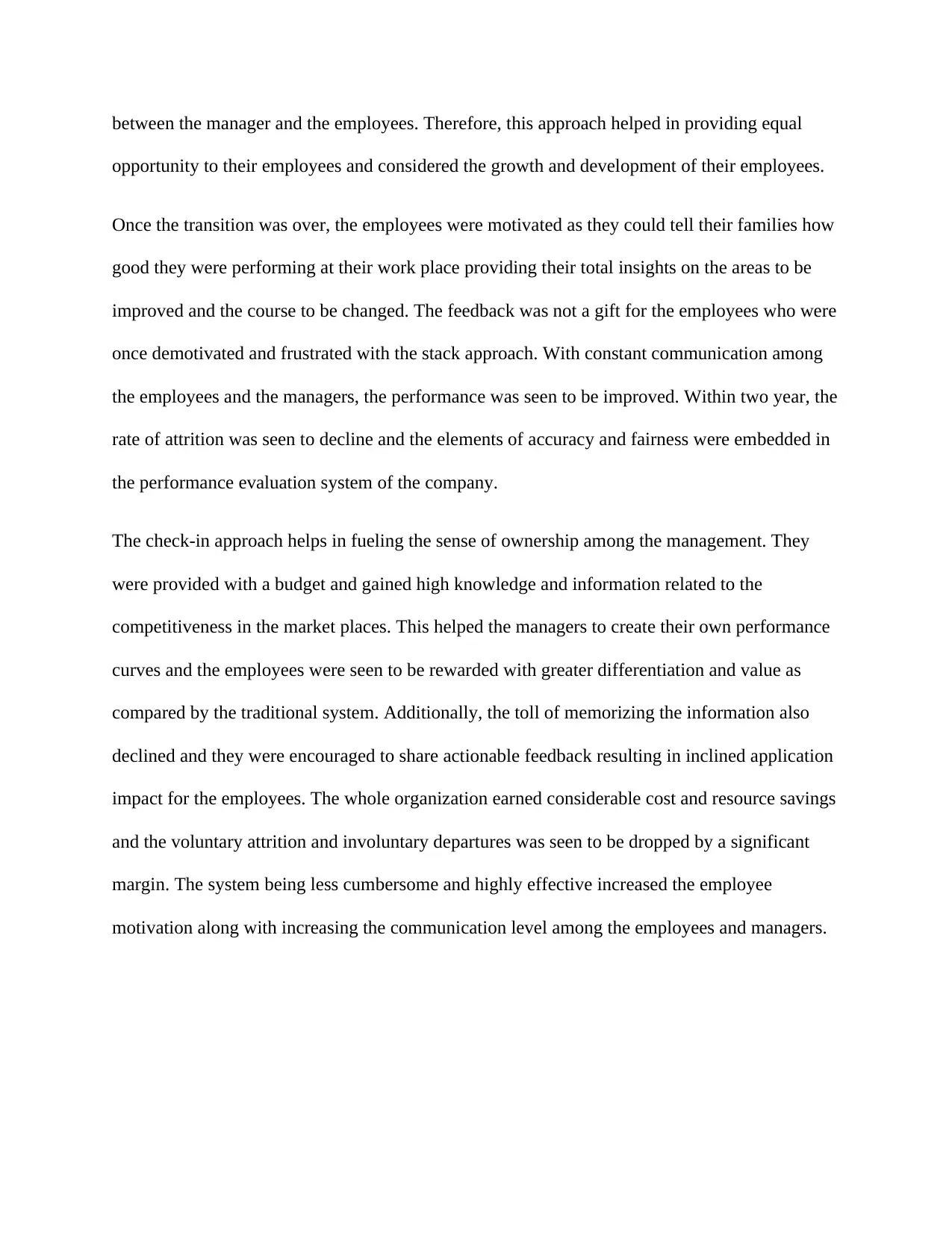
between the manager and the employees. Therefore, this approach helped in providing equal
opportunity to their employees and considered the growth and development of their employees.
Once the transition was over, the employees were motivated as they could tell their families how
good they were performing at their work place providing their total insights on the areas to be
improved and the course to be changed. The feedback was not a gift for the employees who were
once demotivated and frustrated with the stack approach. With constant communication among
the employees and the managers, the performance was seen to be improved. Within two year, the
rate of attrition was seen to decline and the elements of accuracy and fairness were embedded in
the performance evaluation system of the company.
The check-in approach helps in fueling the sense of ownership among the management. They
were provided with a budget and gained high knowledge and information related to the
competitiveness in the market places. This helped the managers to create their own performance
curves and the employees were seen to be rewarded with greater differentiation and value as
compared by the traditional system. Additionally, the toll of memorizing the information also
declined and they were encouraged to share actionable feedback resulting in inclined application
impact for the employees. The whole organization earned considerable cost and resource savings
and the voluntary attrition and involuntary departures was seen to be dropped by a significant
margin. The system being less cumbersome and highly effective increased the employee
motivation along with increasing the communication level among the employees and managers.
opportunity to their employees and considered the growth and development of their employees.
Once the transition was over, the employees were motivated as they could tell their families how
good they were performing at their work place providing their total insights on the areas to be
improved and the course to be changed. The feedback was not a gift for the employees who were
once demotivated and frustrated with the stack approach. With constant communication among
the employees and the managers, the performance was seen to be improved. Within two year, the
rate of attrition was seen to decline and the elements of accuracy and fairness were embedded in
the performance evaluation system of the company.
The check-in approach helps in fueling the sense of ownership among the management. They
were provided with a budget and gained high knowledge and information related to the
competitiveness in the market places. This helped the managers to create their own performance
curves and the employees were seen to be rewarded with greater differentiation and value as
compared by the traditional system. Additionally, the toll of memorizing the information also
declined and they were encouraged to share actionable feedback resulting in inclined application
impact for the employees. The whole organization earned considerable cost and resource savings
and the voluntary attrition and involuntary departures was seen to be dropped by a significant
margin. The system being less cumbersome and highly effective increased the employee
motivation along with increasing the communication level among the employees and managers.
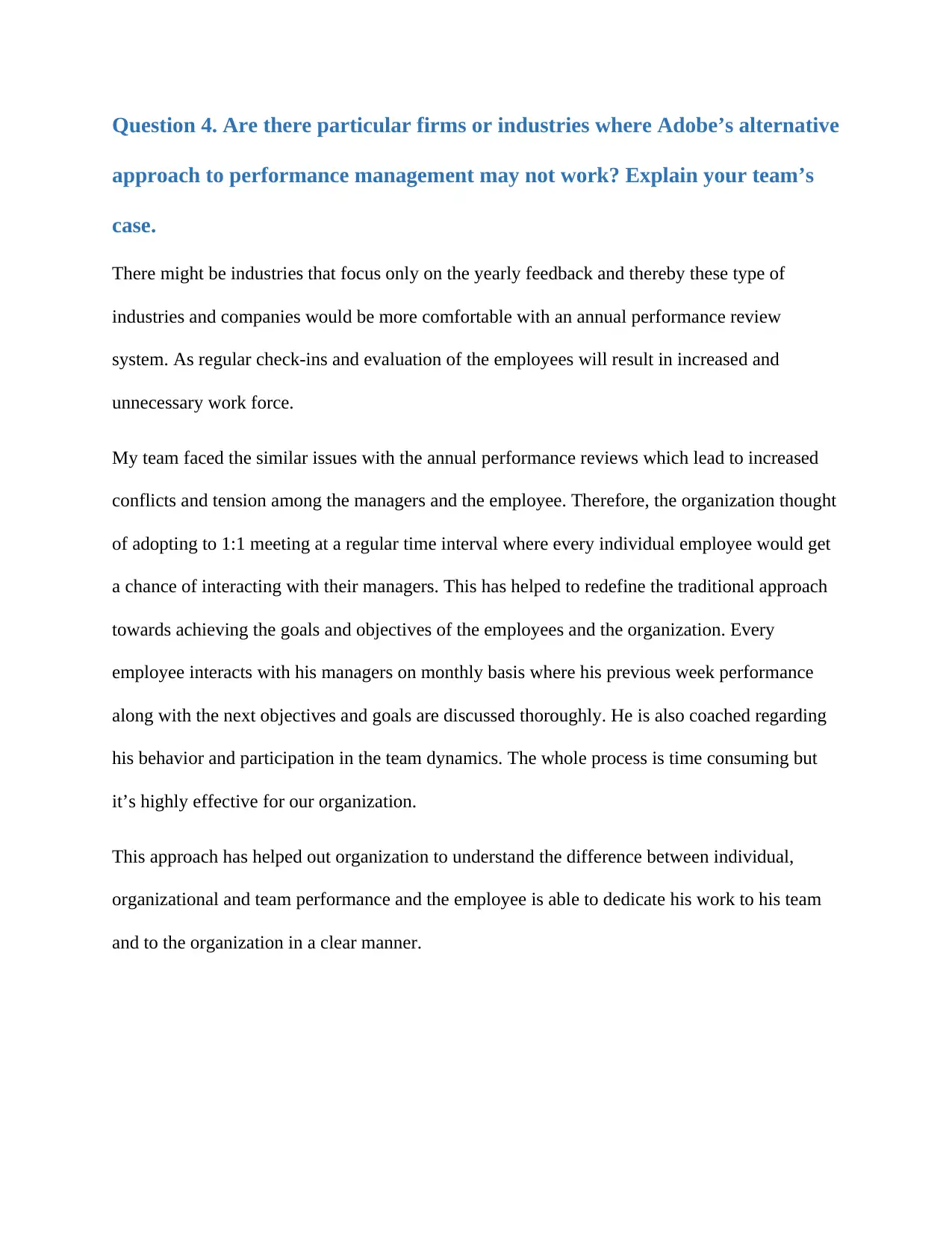
Question 4. Are there particular firms or industries where Adobe’s alternative
approach to performance management may not work? Explain your team’s
case.
There might be industries that focus only on the yearly feedback and thereby these type of
industries and companies would be more comfortable with an annual performance review
system. As regular check-ins and evaluation of the employees will result in increased and
unnecessary work force.
My team faced the similar issues with the annual performance reviews which lead to increased
conflicts and tension among the managers and the employee. Therefore, the organization thought
of adopting to 1:1 meeting at a regular time interval where every individual employee would get
a chance of interacting with their managers. This has helped to redefine the traditional approach
towards achieving the goals and objectives of the employees and the organization. Every
employee interacts with his managers on monthly basis where his previous week performance
along with the next objectives and goals are discussed thoroughly. He is also coached regarding
his behavior and participation in the team dynamics. The whole process is time consuming but
it’s highly effective for our organization.
This approach has helped out organization to understand the difference between individual,
organizational and team performance and the employee is able to dedicate his work to his team
and to the organization in a clear manner.
approach to performance management may not work? Explain your team’s
case.
There might be industries that focus only on the yearly feedback and thereby these type of
industries and companies would be more comfortable with an annual performance review
system. As regular check-ins and evaluation of the employees will result in increased and
unnecessary work force.
My team faced the similar issues with the annual performance reviews which lead to increased
conflicts and tension among the managers and the employee. Therefore, the organization thought
of adopting to 1:1 meeting at a regular time interval where every individual employee would get
a chance of interacting with their managers. This has helped to redefine the traditional approach
towards achieving the goals and objectives of the employees and the organization. Every
employee interacts with his managers on monthly basis where his previous week performance
along with the next objectives and goals are discussed thoroughly. He is also coached regarding
his behavior and participation in the team dynamics. The whole process is time consuming but
it’s highly effective for our organization.
This approach has helped out organization to understand the difference between individual,
organizational and team performance and the employee is able to dedicate his work to his team
and to the organization in a clear manner.
⊘ This is a preview!⊘
Do you want full access?
Subscribe today to unlock all pages.

Trusted by 1+ million students worldwide
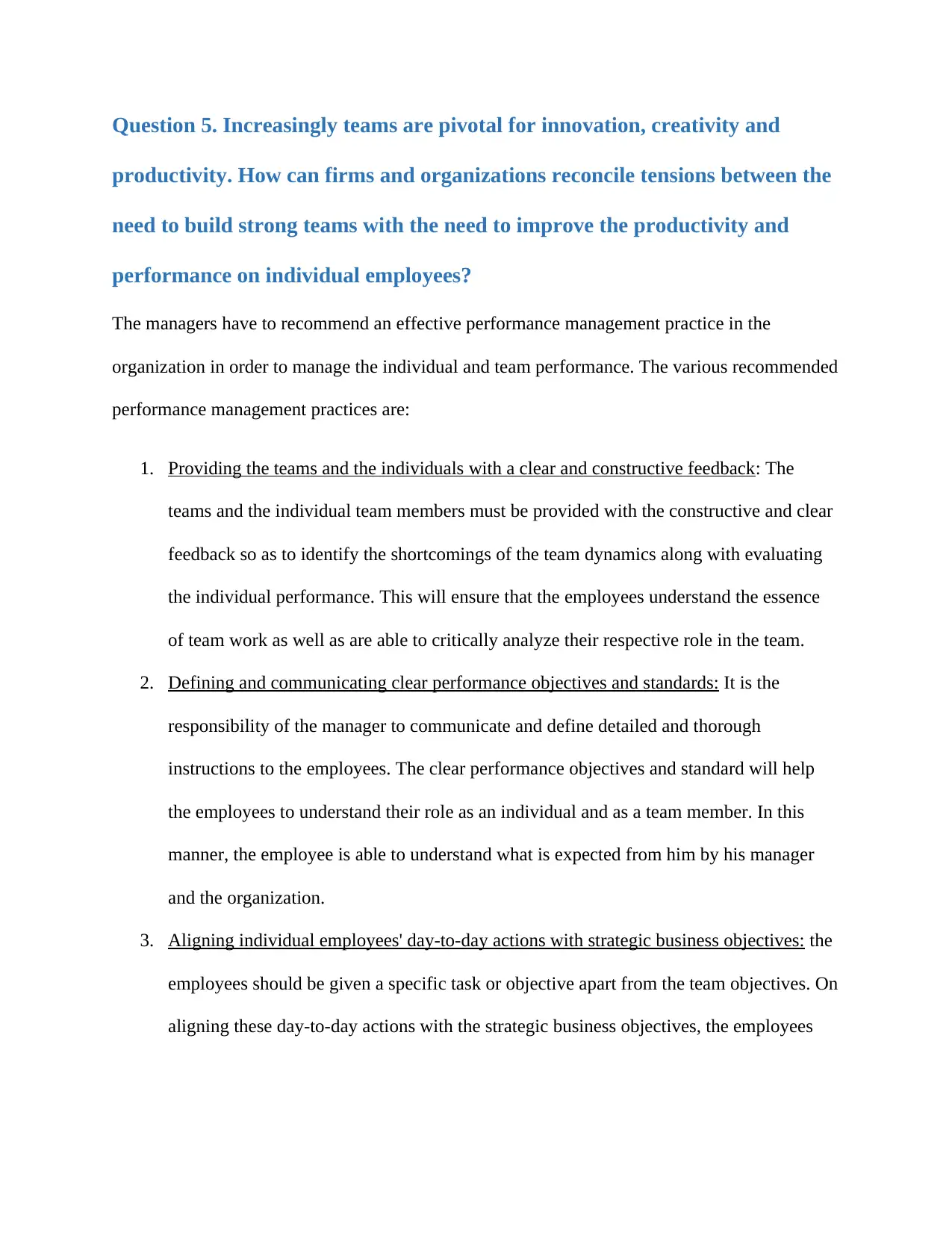
Question 5. Increasingly teams are pivotal for innovation, creativity and
productivity. How can firms and organizations reconcile tensions between the
need to build strong teams with the need to improve the productivity and
performance on individual employees?
The managers have to recommend an effective performance management practice in the
organization in order to manage the individual and team performance. The various recommended
performance management practices are:
1. Providing the teams and the individuals with a clear and constructive feedback: The
teams and the individual team members must be provided with the constructive and clear
feedback so as to identify the shortcomings of the team dynamics along with evaluating
the individual performance. This will ensure that the employees understand the essence
of team work as well as are able to critically analyze their respective role in the team.
2. Defining and communicating clear performance objectives and standards: It is the
responsibility of the manager to communicate and define detailed and thorough
instructions to the employees. The clear performance objectives and standard will help
the employees to understand their role as an individual and as a team member. In this
manner, the employee is able to understand what is expected from him by his manager
and the organization.
3. Aligning individual employees' day-to-day actions with strategic business objectives: the
employees should be given a specific task or objective apart from the team objectives. On
aligning these day-to-day actions with the strategic business objectives, the employees
productivity. How can firms and organizations reconcile tensions between the
need to build strong teams with the need to improve the productivity and
performance on individual employees?
The managers have to recommend an effective performance management practice in the
organization in order to manage the individual and team performance. The various recommended
performance management practices are:
1. Providing the teams and the individuals with a clear and constructive feedback: The
teams and the individual team members must be provided with the constructive and clear
feedback so as to identify the shortcomings of the team dynamics along with evaluating
the individual performance. This will ensure that the employees understand the essence
of team work as well as are able to critically analyze their respective role in the team.
2. Defining and communicating clear performance objectives and standards: It is the
responsibility of the manager to communicate and define detailed and thorough
instructions to the employees. The clear performance objectives and standard will help
the employees to understand their role as an individual and as a team member. In this
manner, the employee is able to understand what is expected from him by his manager
and the organization.
3. Aligning individual employees' day-to-day actions with strategic business objectives: the
employees should be given a specific task or objective apart from the team objectives. On
aligning these day-to-day actions with the strategic business objectives, the employees
Paraphrase This Document
Need a fresh take? Get an instant paraphrase of this document with our AI Paraphraser
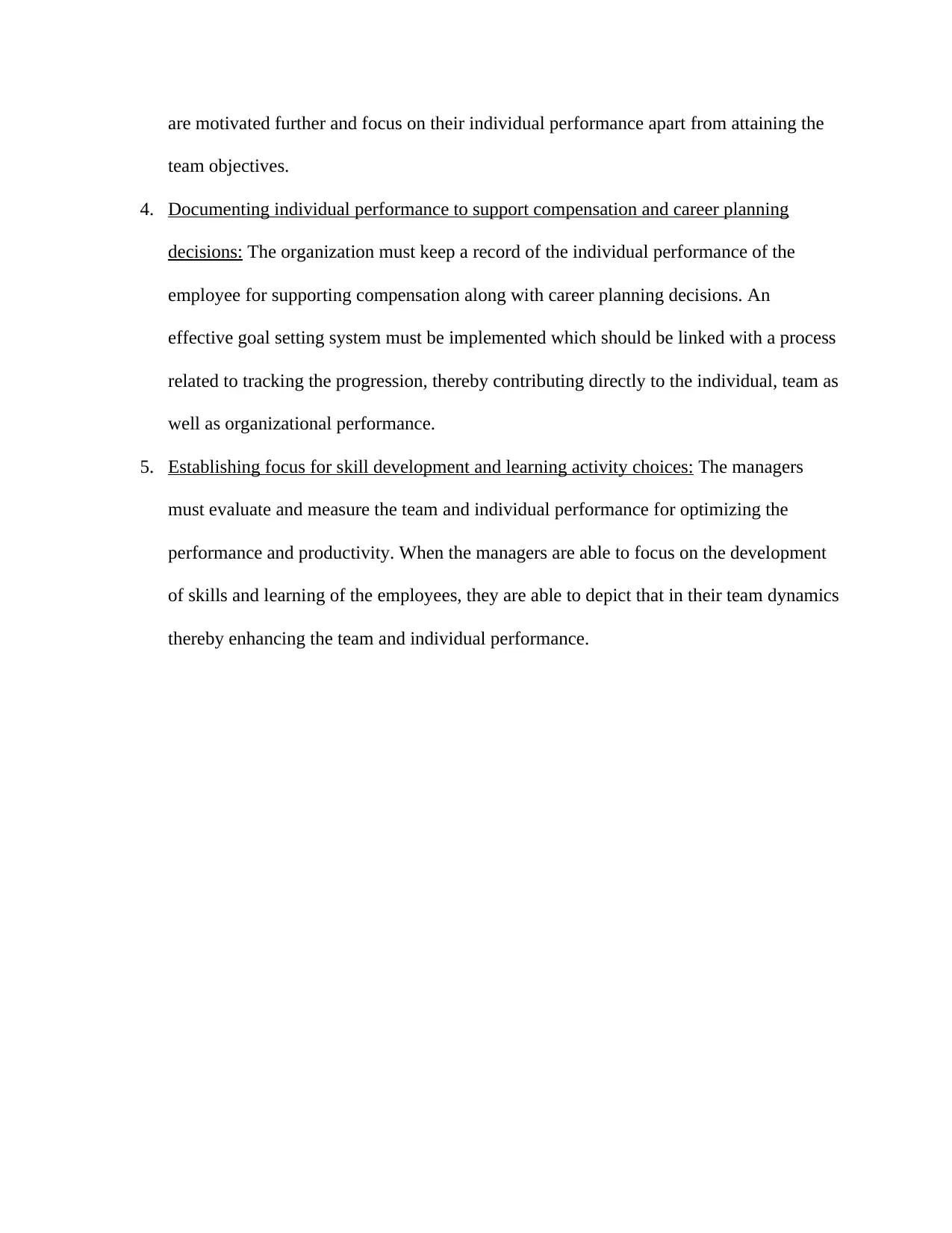
are motivated further and focus on their individual performance apart from attaining the
team objectives.
4. Documenting individual performance to support compensation and career planning
decisions: The organization must keep a record of the individual performance of the
employee for supporting compensation along with career planning decisions. An
effective goal setting system must be implemented which should be linked with a process
related to tracking the progression, thereby contributing directly to the individual, team as
well as organizational performance.
5. Establishing focus for skill development and learning activity choices: The managers
must evaluate and measure the team and individual performance for optimizing the
performance and productivity. When the managers are able to focus on the development
of skills and learning of the employees, they are able to depict that in their team dynamics
thereby enhancing the team and individual performance.
team objectives.
4. Documenting individual performance to support compensation and career planning
decisions: The organization must keep a record of the individual performance of the
employee for supporting compensation along with career planning decisions. An
effective goal setting system must be implemented which should be linked with a process
related to tracking the progression, thereby contributing directly to the individual, team as
well as organizational performance.
5. Establishing focus for skill development and learning activity choices: The managers
must evaluate and measure the team and individual performance for optimizing the
performance and productivity. When the managers are able to focus on the development
of skills and learning of the employees, they are able to depict that in their team dynamics
thereby enhancing the team and individual performance.
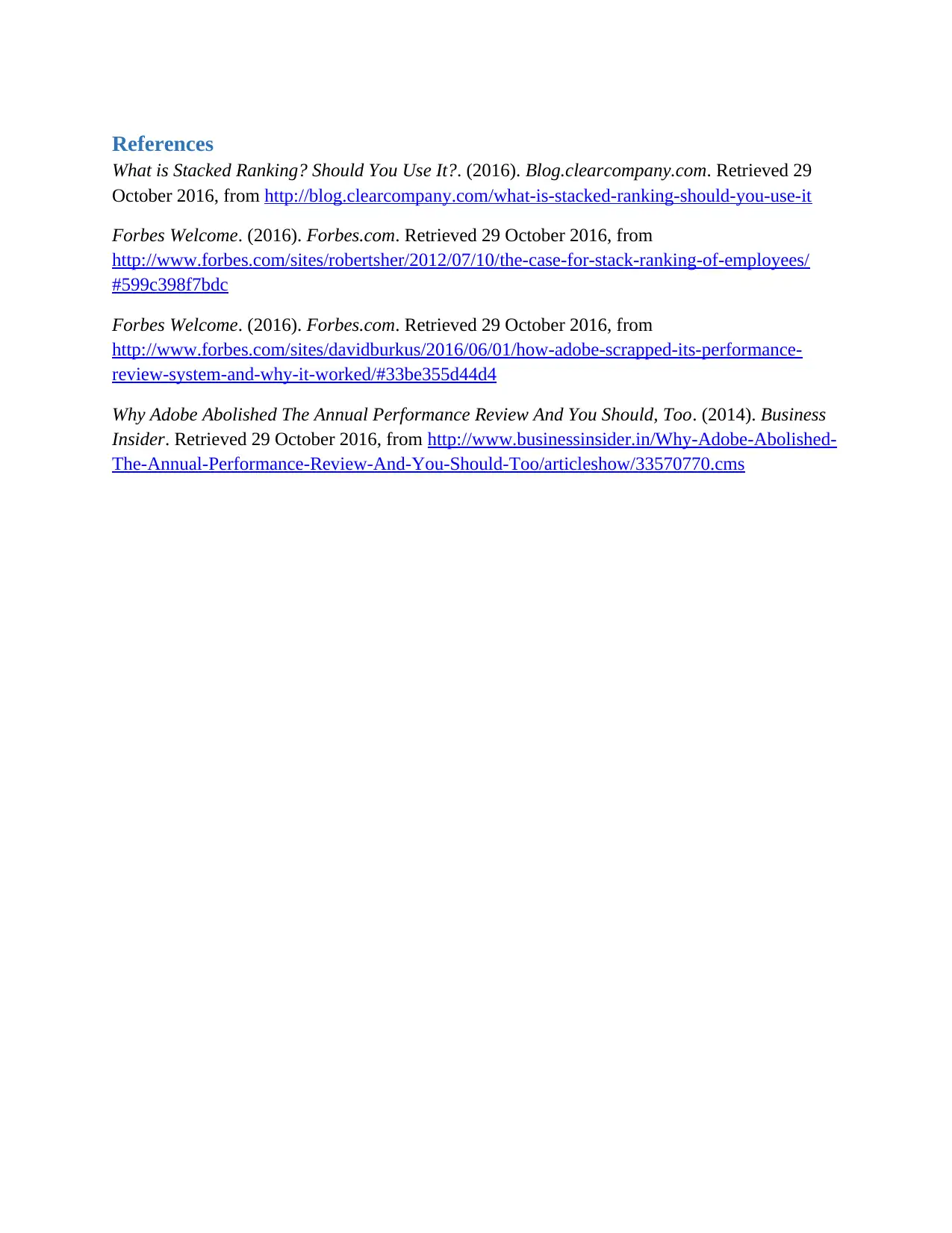
References
What is Stacked Ranking? Should You Use It?. (2016). Blog.clearcompany.com. Retrieved 29
October 2016, from http://blog.clearcompany.com/what-is-stacked-ranking-should-you-use-it
Forbes Welcome. (2016). Forbes.com. Retrieved 29 October 2016, from
http://www.forbes.com/sites/robertsher/2012/07/10/the-case-for-stack-ranking-of-employees/
#599c398f7bdc
Forbes Welcome. (2016). Forbes.com. Retrieved 29 October 2016, from
http://www.forbes.com/sites/davidburkus/2016/06/01/how-adobe-scrapped-its-performance-
review-system-and-why-it-worked/#33be355d44d4
Why Adobe Abolished The Annual Performance Review And You Should, Too. (2014). Business
Insider. Retrieved 29 October 2016, from http://www.businessinsider.in/Why-Adobe-Abolished-
The-Annual-Performance-Review-And-You-Should-Too/articleshow/33570770.cms
What is Stacked Ranking? Should You Use It?. (2016). Blog.clearcompany.com. Retrieved 29
October 2016, from http://blog.clearcompany.com/what-is-stacked-ranking-should-you-use-it
Forbes Welcome. (2016). Forbes.com. Retrieved 29 October 2016, from
http://www.forbes.com/sites/robertsher/2012/07/10/the-case-for-stack-ranking-of-employees/
#599c398f7bdc
Forbes Welcome. (2016). Forbes.com. Retrieved 29 October 2016, from
http://www.forbes.com/sites/davidburkus/2016/06/01/how-adobe-scrapped-its-performance-
review-system-and-why-it-worked/#33be355d44d4
Why Adobe Abolished The Annual Performance Review And You Should, Too. (2014). Business
Insider. Retrieved 29 October 2016, from http://www.businessinsider.in/Why-Adobe-Abolished-
The-Annual-Performance-Review-And-You-Should-Too/articleshow/33570770.cms
⊘ This is a preview!⊘
Do you want full access?
Subscribe today to unlock all pages.

Trusted by 1+ million students worldwide
1 out of 9
Related Documents
Your All-in-One AI-Powered Toolkit for Academic Success.
+13062052269
info@desklib.com
Available 24*7 on WhatsApp / Email
![[object Object]](/_next/static/media/star-bottom.7253800d.svg)
Unlock your academic potential
Copyright © 2020–2025 A2Z Services. All Rights Reserved. Developed and managed by ZUCOL.


